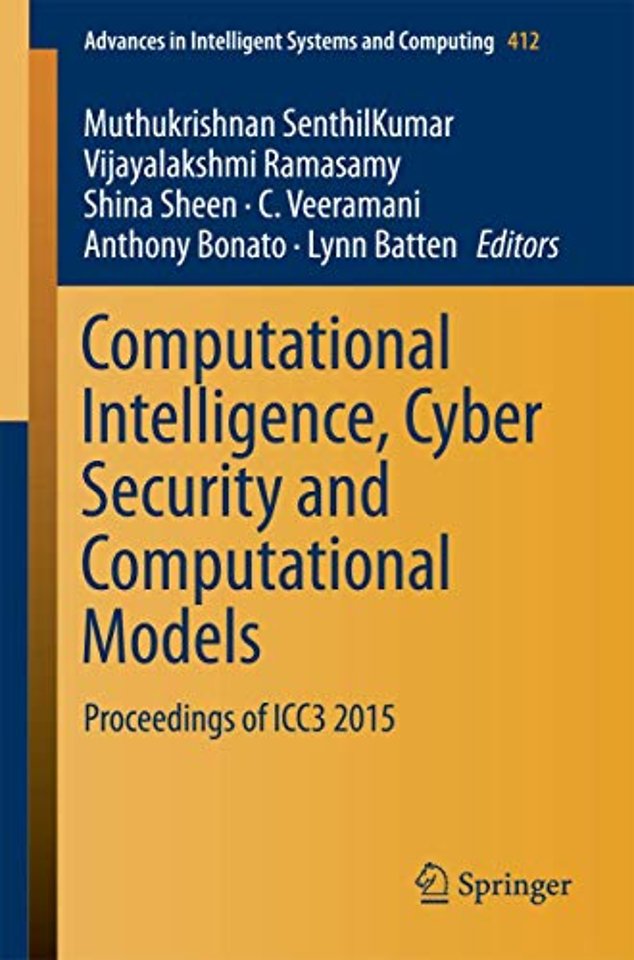Computational Intelligence, Cyber Security and Computational Models
Proceedings of ICC3 2015
Samenvatting
This book
aims at promoting high-quality research by researchers and practitioners from
academia and industry at the International
Conference on Computational Intelligence, Cyber Security, and Computational
Models ICC3 2015 organized by PSG College of Technology, Coimbatore, India
during December 17 – 19, 2015. This book enriches with innovations in broad
areas of research like computational modeling, computational intelligence and
cyber security. These emerging inter disciplinary research areas have helped to
solve multifaceted problems and gained lot of attention in recent years. This
encompasses theory and applications, to provide design, analysis and modeling
of the aforementioned key areas.
Specificaties
Inhoudsopgave
2. Smartphone Applications, Malware
and Data Theft.- 3. Towards Evolutionary Multitasking: A New Paradigm in Evolutionary Computation.- 4. Generating a Standardized Upper Ontology for Security of Information and
Networks.- Part II_Computational Intelligence: Chapter 1. Analysis of Throat Microphone Using MFCC
features for Speaker Recognition.- Chapter 2. Single-pixel Based Double
Random-Phase Encoding Technique.- Chapter 3. Kernel Online Multi-task
Learning.- Chapter 4. Performance Evaluation of Sentiment
Classification Using Query Strategies in a Pool Based Active Learning Scenario.-
Chapter 5. An Enhanced Image Watermarking Scheme Using Blocks
with Homogeneous Feature Distribution.- Chapter
6. Performance Analysis of ApEn as
a Feature Extraction Technique and Time Delay Neural Networks, Multi-layer
Perceptron as Post Classifiers for the Classification of Epilepsy Risk Levels
from EEG Signals.- Chapter 7.
Suspicious Human Activity Detection in
Classroom Examination.- Chapter 8. H ∞
State
Estimation of Discrete Time Delayed Neural Networks with Multiple Missing Measurements
Using Second Order Reciprocal Convex Approach.- Chapter 9. A Fuzzy
Methodology for Clustering Text Documents with Uncertain Spatial References.- Chapter
10. A Novel Feature Extraction Algorithm from
Fingerprint Image in Wavelet Domain.- Chapter 11. Motor
imagery Classification Based on Variable Precision Multigranulation Rough Set.-
Chapter 12. Fault Tolerant and Energy Efficient Signal Processing on FPGA Using Evolutionary
Techniques.- Chapter 13. A Two Phase Approach for Efficient Clustering
of Web Services.- Chapter 14. Elimination of Redundant Association Rules
– An Efficient Linear Approach.- Chapter 15. Clustering Techniques from
Significance Analysis of Microarrays.- Chapter 16. Breast Region
Extraction and Pectoral Removal by Pixel Constancy Constraint approach in
Mammograms.- Chapter 17. Bridging the Semantic Gap in Image Search via
Visual Semantic Descriptors by Integrating Text and Visual Features.- Chapter
18. Adaptive Equalization Algorithm for Electrocardiogram Signal
Transmission.- Chapter 19. An Efficient Approach for MapReduce
Result Verification.- Chapter 20. Improving Lifetime of Memory Devices Using Evolutionary
Computing Based Error Correction Coding.- Chapter 21. Comparison of
Machine Learning Techniques for the Identification of the Stages of Parkinson's
Disease.- Chapter 22. Security Constrained Unit Commitment Problem Employing
Artificial Computational Intelligence for Wind-thermal Power System.- Chapter
23. Human Gait Recognition Using Fuzzy Logic.- Chapter 24. Detection
and Diagnosis of Dilated and Hypertrophic Cardiomyopathy by Echocardiogram
Sequences Analysis.- Chapter 25. An Elitist Genetic Algorithm Based
Extreme Learning Machine.- Chapter 26.
Formulation and Enhancement of User Adaptive
Access to the Learning Resources in E-Learning Using Fuzzy Inference Engine.- Part III_Cyber Security: Chapter 27. A Robust User Anonymity Preserving Biometric Based Multi-server
Authenticated Key Agreement Scheme.- Chapter
28. Extended Game Theoretic Dirichlet Based Collaborative Intrusion
Detection Systems.- Chapter 29.
Implementation of ECDSA Using Sponge Based Hash Function.- Chapter 30. Contrast-Enhanced Visual Cryptography Schemes Based on
Perfect Reconstruction of White Pixels and Additional Basis Matrix.-
Chapter 31. Hash Based Two Gateway Payment Protocol Ensuring
Accountability with Dynamic ID-verifier for Digital Goods Providers.- Chapter 32. Decrypting
Shared Encrypted Data Files Stored in a Cloud Using Dynamic Key Aggregation.- Chapter 33. A Lock and Key Share (2,m,n) Random Grid Visual Secret Sharing Scheme
with XOR and OR Decryptions.- Chapter 34. Multilevel Multimedia Security by Integrating Visual Cryptography and
Steganography Techniques.- Chapter 35. K
out of N Secret Sharing Scheme with Steganography and Authentication.- Chapter 36. A Centralized Trust Computation Model (CTC) for Secure Group Formation in
Military Based Mobile Ad-hoc Networks Using Stereotypes.- Chapter
37. Cost Effective Re-keying Approach for Dynamic Membership Changes in Group Key
Management.- Chapter 38. A Multipath Routing Protocol which Preserves Security and Anonymity of
Data in Mobile Ad-hoc Networks.- Chapter 39. An Efficient Continuous Auditing Methodology for Outsourced Data Storage
in Cloud Computing.- Part IV_Computational Models: Chapter 40. A Study on Building
Seamless Communication Among Vehicles in Vanet Using the Integrated Agent
Communication Model (IACM).- Chapter 41.
A Hybrid Approach for Data Hiding
through Chaos Theory and Reversible Integer Mapping.-
Chapter 42. Fluid Queue Driven by an M/E2/1 Queuing Model.- Chapter 43. An Effective Tool
for optimizing the Number of Test Paths in Data Flow Testing for Anomaly
Detection.- Chapter 44. Venus Flytrap
Optimization.- Chapter 45.
Zumkeller Cordial
Labeling of Graphs.- Chapter
46. Cuckoo Based
Resource Allocation for Mobile Cloud Environments.- Chapter 47. Transient Analysis
of an M/M/c Queue Subject to Multiple Exponential Vacation.- Chapter 48. Fractional Filter Based
Internal Model Controller for Nonlinear Process.- Chapter 49. A Novel Method for
Solving Triangular and Trapezoidal Intuitionistic Fuzzy Games Using Dominance
Property and Oddment Method.</p>

